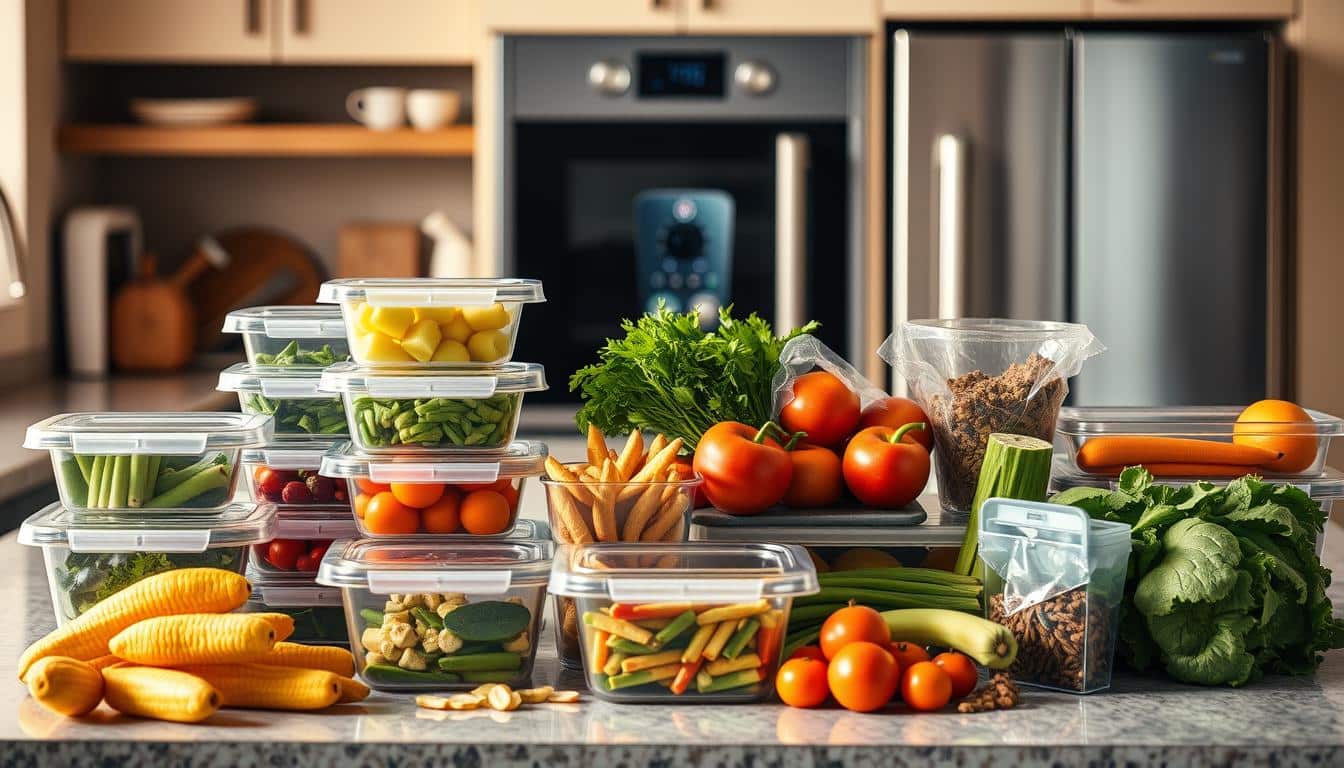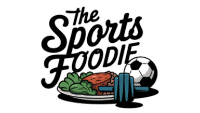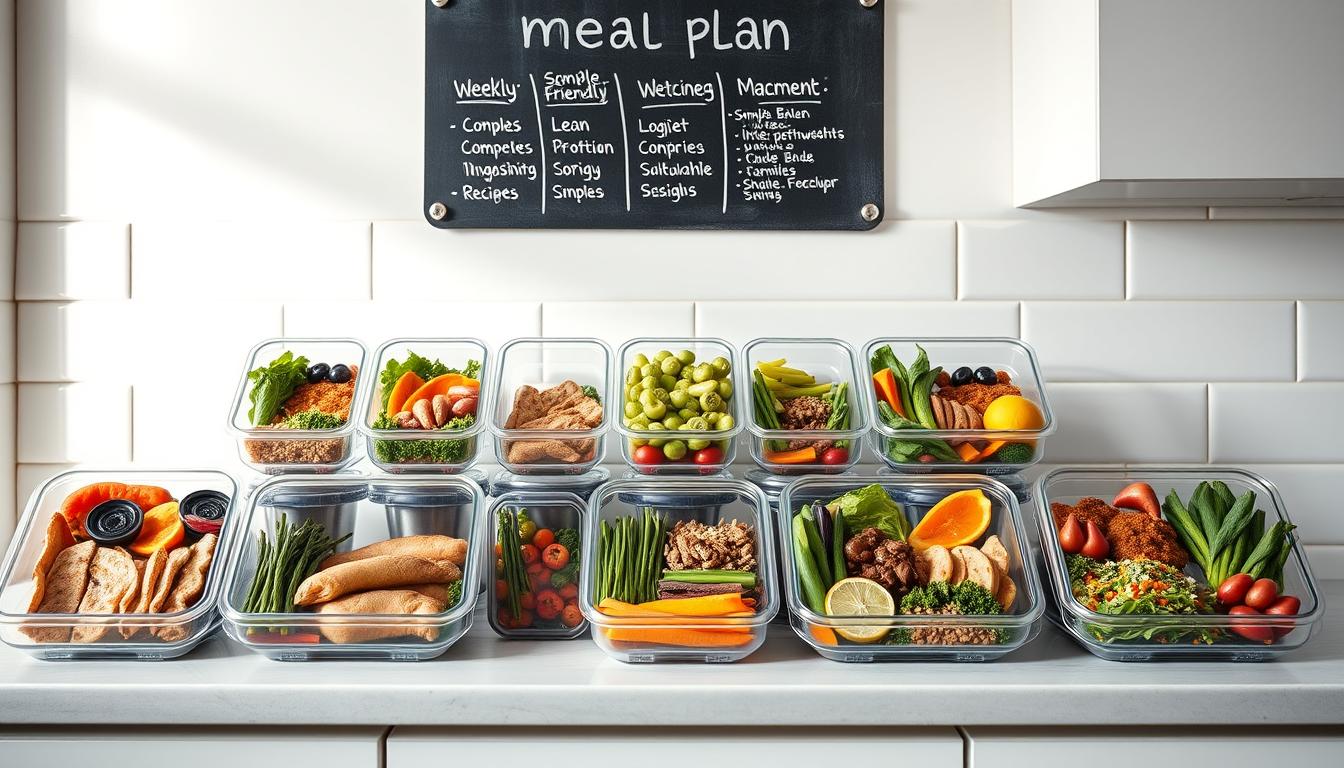Did you know many competitive athletes prep food in blocks of 3–4 days to save hours each week and cut food waste by up to half?
I’ve used a simple plan like this to stay fueled and rested between sessions. You get a clear path to fast, balanced meals that support recovery and performance.
Save time: Bulk-cook grains, roast veggies, and use a rotisserie chicken to speed dinner. Cut stress: Portion snacks and label containers so grabs are instant.
This piece gives straightforward tips and a short plan you can repeat. It also covers storage, common mistakes to avoid, and quick pre- and post-workout fuel ideas.
Search intent and what you will learn
When you’re juggling long training days and travel, planning food removes guesswork and keeps nutrition consistent.

This section answers what you need and what you’ll walk away with. You’ll see practical steps that match your training and workouts. The focus is short actions that save time and reduce stress.
What you’ll learn:
- How to plan meals around training and busy days.
- Which items to prep first so you gain back time during the week.
- Ideas for proteins, carbs, and veggies that hold up well.
- Quick one-pot and sheet pan options that cut cleanup.
- How to pick overlapping ingredients to simplify your shopping list and schedule.
- How to portion for the fridge and freezer, with a step-by-step flow and a copyable sample.
- Common mistakes and fast pre-workout and post-workout meals that actually work.
By the end you’ll have a short checklist you can use every cycle. I’ll keep it practical and doable. You’ll be ready to plan, cook, and stay fueled while you train.
Benefits of meal prep for athletes
Getting food ready ahead of time gives you more hours to train and less time scrubbing pans. Batch cooking cuts daily work into one session. That saves both time and headaches.

Save time and cut cleanup
Cook once, eat several times. Batch cleanup is faster than cleaning after each dinner. You get more free evenings and fewer dishes.
Support training, recovery, and energy
Planned meals make it easier to match carbs and protein to your sessions. That supports recovery and steady energy across the day. Pre-portioned servings help you hit nutrition goals without guesswork.
Reduce stress and save money
A simple plan lowers decision stress after hard workouts. Buying overlapping ingredients in bulk cuts grocery costs. A stocked fridge also reduces takeout and food waste.
- Meal prep saves time because you cook once and eat many times.
- Batch cleanup is faster than cleaning after every meal.
- Prepped meals help you hit nutrition targets with less effort.
- Pre-portioning prevents overeating and simplifies choices.
- Consistent fueling keeps energy steady through the week.
Plan your week around training sessions
Start your week by aligning meals with training blocks to keep energy steady. Write your training sessions next to each day on a calendar. This makes choices obvious when you’re tired.
Match hard days with higher-carb meals
Put carbs on heavy days. That supports endurance and speeds recovery. Add a pre-workout carb option for every hard session.
Use rest or low-load days for prep
Block 1–2 hours on an easy day to cook proteins, grains, and veggies. Pack snacks for long practice or back-to-back sessions.
- Map your week: write sessions next to each meal.
- Keep a backup frozen dish for surprises.
- Adjust portions up on long days and down on light days.
- Review your schedule on Sunday and tweak midweek.
| Time | Carb Focus | Prep Task |
|---|---|---|
| Hard morning | High carbs | Cook oats, pack banana |
| Rest day | Lower carbs | Batch proteins & grains |
| Long day | Increase portions | Pack extra snack |
Keep this plan flexible. Check your schedule each week and make small updates midweek. You’ll stay fueled and less stressed during training.
Create a simple grocery list with overlapping ingredients
Choose a few versatile foods and you’ll simplify every shopping trip. This keeps costs down and reduces waste.
Pick proteins, carbs, and veggies that repeat well. Use chicken across wraps, salads, and soups. Roast sweet potatoes for dinner and breakfast scrambles. Add spinach to smoothies, stir-fries, and salads.
Shop sales and seasonal produce
Check sale ads and swap in-season produce. Seasonals taste better and cost less. Buy bulk packs of proteins and grains to lower cost per serving.
Add grab-and-go snacks to your cart
- Write a grocery list that reuses ingredients across meals.
- Choose one protein, one grain, and two veggies you can repeat.
- Add snack staples: yogurt, cottage cheese, nuts, and fruit.
- Include pantry items like oats, hummus, and whole-grain wraps.
| Base | Example | Uses |
|---|---|---|
| Protein | Chicken | Wraps, soups, salads |
| Grain | Rice or quinoa | Bowls, sides, breakfasts |
| Veggies | Sweet potatoes, broccoli | Roast, scramble, roast again |
Stick to your list during grocery shopping. Small planning moves save money and make weekday meals less stressful.
Batch cooking basics that save hours
Spend one focused block in the kitchen and reclaim hours later in the week. Batch cooking is a small habit that frees time and keeps nutrition steady.
Cook double at dinner and save portions for tomorrow’s lunch. Make this a rule: double or triple dinners when you can.
Make a bulk pot of rice or quinoa as your anchor. A big pot of rice stores well and speeds up dozens of quick plates.
Shred a rotisserie chicken and split it across wraps, salads, soups, and bowls. Pre-portion proteins into 4–6 oz servings so grabbing food is instant.
- Cook double at dinner and save portions for tomorrow’s lunch.
- Make a bulk pot of rice or quinoa to anchor fast meals.
- Shred a rotisserie chicken and split it across three dishes.
- Pre-portion proteins into 4–6 oz servings for fast grabs.
- Roast two trays of veggies to cover several meals.
Store grains and proteins in separate containers. Keep sauces on the side so flavors stay bright all week.
| Task | Goal | Time |
|---|---|---|
| Double dinner | Lunch ready | 0 extra prep |
| Bulk grains | Base for plates | 30–40 minutes |
| Shred chicken | 3 quick meals | 10 minutes |
- Set a timer so batch cooking stays under two hours.
- Label portions and dates to track freshness.
- Clean as you go to keep batch cooking smooth.
Use sheet pan and one-pot meals for fast prep
Sheet-tray dinners and simmered pots cut hands-on time and speed cleanup. Toss carbs, protein, and veggies on a single surface. Then bake or simmer and you’ve got a ready dinner that stores well.
Sheet pan ideas: chicken, sweet potatoes, and veggies
Build a full plate on one sheet. Use chicken, sweet potatoes, and broccoli. Drizzle olive oil, sprinkle salt, pepper, and a simple spice mix. Roast until the chicken hits safe temperature and the veg is tender.
- Quick tip: Line the sheet with parchment for fast cleanup.
- Cut everything similar in size so it cooks evenly.
- Cook extra portions to cover lunch the next day.
One-pot ideas: soups, chili, and grain skillets
One pot means fewer pans and faster washes. Try a bean chili with lean meat and tomatoes. Or stir together rice or quinoa, mixed veggies, and broth for a grain skillet. Let it simmer until the flavors meld.
| Combo | Main steps | Hands-on time |
|---|---|---|
| Chicken + sweet potato + broccoli | Toss, roast 25–35 min | 10–15 min |
| Bean chili | Sear meat, add beans & simmer | 10 min |
| Grain skillet | Sauté veg, add grain & simmer | 12–18 min |
Rotate spices to change flavors without new recipes. Pre-cut ingredients to keep hands-on time under 15 minutes. Store components separately if you want to mix plates later.
Protein prep made easy
Good protein prep makes grocery day feel like a win and dinner feel automatic. Keep steps simple so you actually do them between sessions.
Portion guidance: Cut chicken, fish, or steak into 4–6 oz packs. That size hits common targets and keeps tracking straightforward.
Pre-portion chicken, fish, or steak
Cook breasts, fillets, or steaks, then divide into single portions while warm. Use shallow containers so they cool fast and stay safe.
Boil eggs for quick add-ins
Boil a dozen eggs at once. They’re grab-and-go snacks and an easy salad topper that saves time on busy evenings.
- Pre-portion proteins into 4–6 oz servings for easy tracking.
- Freeze some cooked chicken breasts to extend the week.
- Bake or grill fish and store in airtight containers.
- Sear steak, let it rest, then slice thin for fast assembly.
- Use a rotisserie chicken to speed prepping and vary dishes.
- Keep one marinade and one dry rub to change flavors without fuss.
- Label containers with dates so older ingredients get used first.
| Protein | Best use | Storage tip |
|---|---|---|
| Chicken | Wraps, bowls, soups | Shallow container; refrigerate 3–4 days |
| Fish | Fillet plates, salads | Eat within 2–3 days or freeze single portions |
| Eggs | Snacks, salad toppers | Keep peeled or unpeeled; label with cook date |
Pair each protein with a ready carb and a veg to turn prepped ingredients into complete meals fast. Little structure like this helps an athlete stay fueled with less fuss.
Carb and veggie prep that holds up all week
Roasting and simple steaming give you reliable carbs and veggies that last through the week. Do a single cook block and you’ll have building blocks to finish plates fast.
Roast a full tray of sweet potatoes. Slice them into cubes so they warm fast and work across breakfasts, lunches, and dinners.
Steam broccoli, green beans, or mixed veg. Use a microwave steamer or a pot with a basket. These quick sides reheat well and keep texture.
Oats and grains that anchor plates
Cook a pot of oats and portion it for the week. Use some for overnight jars and some for baked oatmeal. Both save morning time.
Keep a container of cooked rice and other bulk grains. They act as the base for bowls and quick meals.
- Store cooked carbs and veggies in separate containers.
- Keep dressings on the side to protect texture.
- Use sturdy vegetables like carrots and cabbage that last longer.
- Rotate herbs and spices to keep eating interesting.
- Reheat with a splash of water to keep foods moist.
| Task | Why | Timing |
|---|---|---|
| Roast sweet potatoes | Multi-use carb | 30–40 min |
| Steam mixed veggies | Fast sides | 5–10 min |
| Cook oats or rice | Breakfast and bowls | 20–40 min |
Snack prep for busy days
Snacks that travel well make long training days less chaotic and keep hunger from derailing focus.
Make a short ritual: portion trail mix, nuts, and dried fruit into small reusable bags or Stasher bags. Add cubed cheese with whole-grain crackers so a quick plate is ready.
- Portion trail mix, nuts, and dried fruit into grab bags to control serving sizes.
- Prep yogurt or cottage cheese cups with berries; seal and label them.
- Include a spoon and napkin so a snack is truly grab-and-go.
- Keep one sweet and one savory option in your bag each day.
- Aim for a snack that pairs carbs and protein to steady energy.
- Use small containers to cut mess and speed up restocking every 2–3 days.
- Store backup items in your desk or gym bag and log favorite combos so you repeat what works.
| Snack | How to pack | Why it works |
|---|---|---|
| Trail mix | Small bag or Stasher | Portable carbs + fat for sustained energy |
| Cubed cheese + crackers | Separate compartment or box | Protein and carbs in one bite |
| Yogurt cup with fruit | Airtight container, spoon included | Quick protein boost after training |
Storage that keeps food fresh
Smart storage makes the difference between tossed ingredients and ready plates. Use the right tools and a small routine and you’ll save time and money.
Invest in airtight, microwave, and freezer-safe containers
High-quality containers lock in flavor and stop leaks. Pick sets in multiple sizes so you can store full meals or small snacks. Choose microwave- and freezer-safe options to reheat and freeze without switching dishes.
Label portions and dates for easy grabs
Label each container with the meal name, portion, and date. That helps you rotate items and avoid waste. Keep sauces in small side cups so textures stay crisp.
- Use airtight containers to keep flavor and texture.
- Keep multiple sizes for meals, sides, and snacks.
- Cool hot food before sealing to avoid condensation.
- Place oldest meals in front so you grab them first.
- Keep a short list on the fridge door of what’s inside.
| Item | Best use | Tip |
|---|---|---|
| Large container | Full meals and bowls | Freeze portions; label date |
| Medium container | Sides and grains | Stack neatly to save space |
| Small cups | Dressings and sauces | Keep separate until serving |
| Divided tray | Component storage | Prevents soggy mixes |
Smart freezer use for backup meals
A well-stocked freezer acts like a backup coach when your week gets slammed. It gives reliable options when time vanishes and keeps performance on track.
Freeze soups, chili, and pasta bakes in single or family portions. Label each container with the name and date so you rotate stock and nothing gets buried.
Cook a batch and freeze half to save a later cooking block. Freeze extra chicken, ground meat, and fish in flat, labeled bags so portions stack and thaw faster.
Keep quick frozen staples on hand
- Frozen fruit for smoothies and oats.
- Steamable veggie bags as fast sides.
- Chicken sausage, fish, and shrimp for quick protein swaps.
- Lay portions flat to freeze; they stack and thaw faster.
Reheat one-pot meals straight from frozen when you need a no-brainer dinner. Keep a running freezer list on your phone so you avoid duplicates and plan what to top up each week.
| Item | Portioning | Storage tip |
|---|---|---|
| Soups & chili | Single or family jars | Freeze upright, then stack flat |
| Pasta bakes | Individual trays | Use oven-safe containers; reheat covered |
| Proteins (chicken, fish) | 4–6 oz packs or flat bags | Label date; use oldest first |
| Frozen fruit & veg | Measured cups or resealable bags | Keep a variety for smoothies and sides |
How to avoid common meal prep mistakes
A simple rule: plan for three to four days and refresh midweek. That single change keeps food fresh and your routine flexible.
Too much repetition is boring and leads to wasted food. Break monotony by swapping sauces or spices on the same base. That gives new flavors with no extra shopping or time.
Break repetition with small swaps
Change dressings, switch a grain, or add a citrus squeeze. These small moves refresh plates without new recipes.
Keep recipes simple and short
Pick recipes with 4–7 ingredients. Less chopping, fewer steps, and lower chance you’ll skip the whole session.
Prep for three to four days, then refresh midweek
Cook in 3–4 day blocks. Reheat or toss fresh greens midweek. This balance limits waste and keeps texture pleasant.
Plan meals that fit your schedule
Match dishes to your day. Pack cold options for long travel days and reheat heavier plates when you have time. Set a Sunday reminder to review the week.
- Use overlapping ingredients to save money and time.
- Avoid marathon cooking that burns you out.
- Keep a few frozen backup meals for late nights.
- Build a rotation of five meals you enjoy and repeat them.
- Track what worked so you refine your system next week.
| Common mistake | Quick fix | Why it works |
|---|---|---|
| Too much repetition | Swap sauce or spice | New flavor, same base |
| Complex recipes | Choose 4–7 ingredient meals | Less prep, more consistency |
| Ignoring schedule | Match meals to your days | Less wasted food and time |
| Prepping too much | Limit to 3–4 day blocks | Better texture; less spoilage |
Fuel before and after workouts
A short fuel plan before and after training keeps recovery predictable and fast. Use timing and simple foods to support energy and repair.
Quick pre-workout carb ideas
Eat quick carbs 30–60 minutes before hard efforts. Choose options you tolerate well. Keep portions small before intense sessions.
- Banana or half a banana if it’s close to start.
- Applesauce cup or a small granola bar.
- Toast with honey or jam.
Post-workout protein and carb combos
Pair protein and carbs within 60 minutes after workouts to support muscle repair and glycogen refill.
- Yogurt with fruit — fast and portable.
- Turkey and rice bowl from your fridge stash.
- Scrambled eggs with toast for a balanced plate.
| When | What | Why |
|---|---|---|
| 30–60 min before | Simple carbs | Quick energy without heaviness |
| Within 60 min after | Protein + carbs | Support recovery and restore energy |
| Any sweaty session | Fluids + pinch of salt | Replace electrolytes |
Keep a ready snack in your gym bag. Scale portions to session length and intensity. Note caffeine timing if you use it. Log what feels best and repeat winning combos.
For high-energy breakfast ideas that fit this approach, see high-energy breakfast foods.
easy weekly meal prep for athletes: a step-by-step flow
Block out 90–120 minutes and turn groceries into stacked, labeled containers you can use across training days. This short window saves hours and removes decision fatigue.
Follow a clear flow: pick what you’ll eat, build a compact list, shop, then cook in one focused session.
Pick meals, build list, shop, and schedule
- Pick 3 meals and 2 snacks you want this week. (meals)
- Build a short list with overlapping items. (list)
- Do your grocery shopping and stick to the list. (grocery shopping)
- Block a day and a 90–120 minute window for prep. (day)
Cook proteins, carbs, and veggies together
- Cook one protein, one grain, and two veggies at once.
- Cool, portion, and label each container with dates. (prep)
- Store sauces and dressings on the side.
- Set aside two backup freezer meals.
- Place grab-and-go items at eye level in the fridge.
- Schedule a 30-minute midweek refresh to top up. (meal prep)
| Step | Goal | Time |
|---|---|---|
| Plan & list | Clear shopping action | 10–20 min |
| Shop | Buy only what’s on the list | 30–60 min |
| Cook | Batch proteins, grains, veg | 90–120 min |
| Store | Label and stack ready meals | 10–15 min |
Sample three-day prep plan you can repeat
Start with a small, repeatable block that covers three days and keeps choices simple. This format saves time and preserves flavor while you train.
Day one prep block
Day 1: Cook chicken, make a pot of rice, and roast broccoli. Boil a dozen eggs and cook oats for quick breakfasts.
Portion dinners into single containers and label dates so you use the oldest first. That habit keeps food fresh and stress low.
Midweek top-up
On day three or four, roast a second tray of veggies and cook a fresh protein. Swap the protein type or spice mix so flavors change without new recipes.
Mix-and-match meal ideas
Use the same components to build varied plates throughout the week. Keep sauces on the side to change flavors on the fly.
- Build bowls: rice + chicken + roasted veg + sauce.
- Make wraps: sliced chicken, greens, yogurt dressing.
- Toss salads: leafy greens, roasted veggies, eggs, seeds.
- Rotate sauces like salsa, pesto, or peanut sauce to refresh tastes.
- Keep fruit and yogurt cups ready as quick energy snacks.
- Adjust portions to match training load and energy needs.
| When | Action | Why it helps |
|---|---|---|
| Day 1 | Cook chicken, rice, roast broccoli; boil eggs; cook oats | Creates core components that reassemble fast across days |
| Midweek | Roast more veggies; cook a new protein | Refreshes flavor and texture; avoids repetition |
| Any day | Mix bowls, wraps, or salads using leftovers | Keeps variety high with minimal extra work |
Tips to keep variety without extra work
You don’t need new recipes to keep dinners interesting — just switch the finishing touches. Small changes feel fresh. They’ll keep you cooking less and enjoying more.
Change sauces and spices on the same base
Use one base and three sauces to make new plates fast. Try a taco blend one night, Italian herbs the next, and curry powder the third.
Swap a sauce and the whole dish feels different. Add crunch with nuts or seeds to vary texture. Keep a small spice rack you actually use.
Rotate grains and greens
Switch grains to change the base. Use rice, quinoa, or couscous in rotation. Each grain shifts mouthfeel and how sauces cling.
Swap spinach, kale, and romaine to change texture and flavor in salads and bowls. Change a protein cut or the cooking method to shift the plate again.
- Use one base and three sauces to make new meals fast.
- Try taco seasoning, Italian herbs, or curry powder on the same dish.
- Rotate grains like rice, quinoa, and couscous each week.
- Swap greens between spinach, kale, and romaine.
- Change a protein cut or cooking method to shift texture.
- Use a one pot base and finish with a fresh garnish.
- Add crunch with nuts or seeds to change mouthfeel.
- Keep a small spice rack you know and use often.
- Write your favorite combos so you can repeat them.
- Make variety simple so it sticks.
| Move | Quick example | Why it works |
|---|---|---|
| Sauce swap | Yogurt-tahini → salsa → pesto | New flavor, same base |
| Grain rotate | Rice → quinoa → couscous | Texture and cooking time variety |
| Green swap | Spinach → kale → romaine | Leaf texture and bite change |
Conclusion
A small shift in planning can cut decision fatigue and keep your training fuel on point.
These tips show the way: use overlapping ingredients, cook in 3–4 day blocks, and refresh midweek. Label portions and store sauces separately so textures last and grabs are fast.
Keep a few freezer backups to reduce stress when plans change. This method fits the way athletes need food to perform—simple, repeatable, and reliable.
One action: block 90 minutes on your calendar now and run one meal prep session. That single step will save you time and make next week easier.


